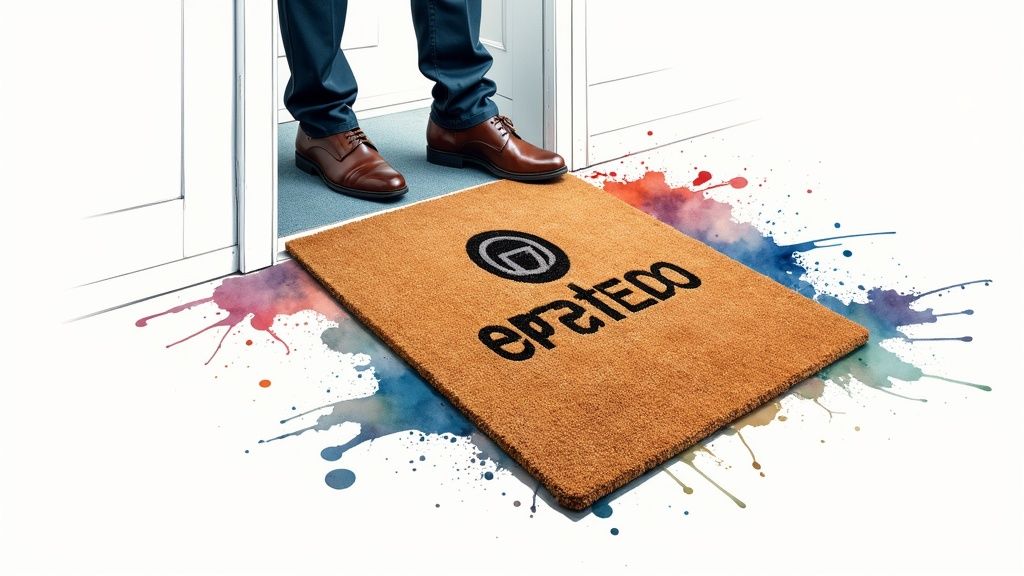Logo door mats are far more than just a functional item for wiping your feet. Think of them as a powerful branding tool, your very first chance to make a professional impression before you’ve even said a word. They’re a subtle but clear signal of your attention to detail and company pride, setting the entire tone for a visitor's experience.
Your First Impression Starts at the Door
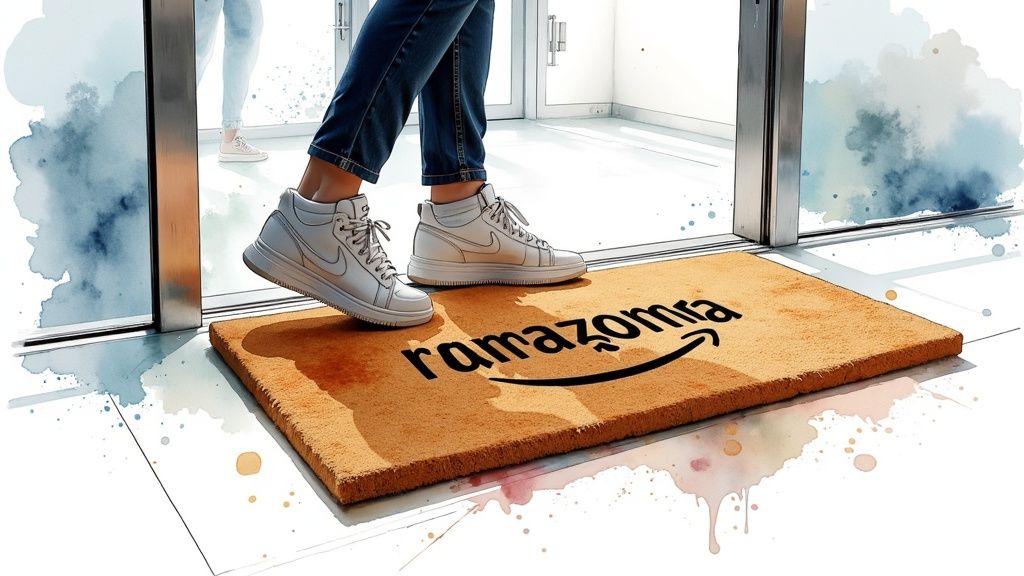
The entrance to your business is the first physical handshake with every client, partner, or potential new hire. A generic, beat-up mat can unintentionally whisper indifference, but a clean, crisp logo mat projects confidence and a real commitment to quality.
This simple addition turns a purely functional space into a strategic part of your marketing. It's a prime opportunity to reinforce your brand identity from the ground up, making your logo one of the first and last things a visitor sees. That subtle repetition is fantastic for building brand recall and creating a positive, lasting association.
Turning a Doorway into a Welcome
Think about the psychological effect for a moment. A well-designed logo mat does more than just greet people; it tells them you care about the little things. This small touch can genuinely shape a visitor’s perception before they even get to your reception desk.
For instance, a high-end salon with a custom mat featuring an elegant logo immediately sets a luxurious, detail-oriented tone. On the other hand, an industrial facility using a heavy-duty logo mat shows it’s serious about both its brand and workplace safety. Each one speaks the language of its industry, loud and clear.
A custom logo mat acts as a silent ambassador for your brand. It works 24/7 to reinforce your identity and signal to every visitor that they are entering a professional and well-managed space.
Why This First Impression Matters
The demand for entrance accessories that are both functional and stylish is booming. The global door mat market was valued at around USD 2.5 billion in 2024 and is on track to hit USD 3.8 billion by 2033. This growth is being fueled by businesses and homeowners who get it—they understand that personalized items like logo door mats are essential for creating a polished, complete look. You can find more data on this market trend to see just how fast it’s expanding.
Ultimately, putting a quality logo mat at your door is a low-cost, high-impact move. Here are the immediate benefits:
- Elevated Brand Perception: It instantly makes your entrance look more professional and established.
- Enhanced Visitor Experience: It helps create a welcoming, branded environment from the second someone arrives.
- Constant Brand Reinforcement: It subtly keeps your logo top-of-mind for everyone coming and going.
Choosing The Right Mat Material And Style
Picking the perfect logo door mat involves more than just slapping your design onto a piece of fabric. The material you choose is the real foundation. It dictates everything—how long the mat will last, how well it grabs dirt, and just how sharp your logo looks after months of foot traffic. Getting this choice right means your mat won't just look great; it will reduce cleaning costs and improve safety.
Think of it like choosing tires for a car. You wouldn't put standard road tires on a heavy-duty truck destined for a muddy construction site. In the same way, that plush, elegant mat that’s perfect for a quiet law firm lobby would be destroyed in a week at the entrance of a busy factory.
Matching Material To Your Environment
First things first: take an honest look at your needs. Where is this mat going to live, and what kind of daily abuse will it face? Answering these questions will point you straight to the best material.
Here's a simple checklist to guide your decision:
- Foot Traffic: How many people are coming through your door every day? A small office with a dozen employees has completely different needs than a retail store that sees hundreds of customers.
- Weather Exposure: Is your mat staying cozy indoors, braving the elements outdoors, or sitting in a covered but exposed entryway? Rain, snow, and direct sun all demand different material strengths.
- Type of Debris: Are you mostly dealing with light dust and a bit of moisture from city streets? Or are you waging a full-on war against grease, caked-on mud, and industrial grime?
Let's break down the most common materials to see how they stack up.
Popular Logo Door Mat Materials
Every material brings a unique mix of benefits to the table. Understanding these differences is the key to making a smart investment in both your brand and your building's cleanliness.
Nylon and Polypropylene (Carpet-Top Mats)
There’s a good reason these synthetic fibers are the go-to choice for indoor logo door mats. They provide a fantastic canvas for high-definition printing, which means complex logos with vibrant, sharp details really pop.
- Real-World Example: Imagine a modern tech startup wants a mat for their main reception that features their detailed, multi-colored logo. A digitally printed nylon mat is the perfect fit. It gives them a professional, carpet-like finish and can reproduce their branding with near-photographic quality, all while absorbing moisture on rainy days.
Coir (Coconut Fiber)
For a classic, rustic look with serious scraping power, you can't beat coir. Made from coconut husks, this natural fiber is incredibly coarse, making it a beast at removing caked-on mud and heavy debris from shoes.
- Real-World Example: A garden center or a farm-to-table restaurant would get great use out of a coir logo mat at their main entrance. The rugged, earthy aesthetic fits the brand perfectly, and its aggressive scraping action stops soil and dirt in its tracks.
Rubber
When durability is the name of the game, rubber is the undisputed champ. These mats are built for tough outdoor or high-traffic industrial settings. Logos aren't just printed on top; they are physically molded into the surface, creating a 3D effect that is practically indestructible.
- Real-World Example: Think of a busy warehouse or distribution center. They need a mat at the loading dock entrance that can handle forklifts, heavy carts, and constant foot traffic. A heavy-duty, all-rubber custom logo mat is the only real solution here, standing up to extreme wear while scraping grime from work boots.
Choosing the right material is an investment in both your brand's image and your building's function. A well-chosen mat will cut down on cleaning costs, boost safety, and represent your brand with class for years.
The visual style of your logo mat is just as crucial as its material. This chart reveals the most popular design approaches businesses are taking.
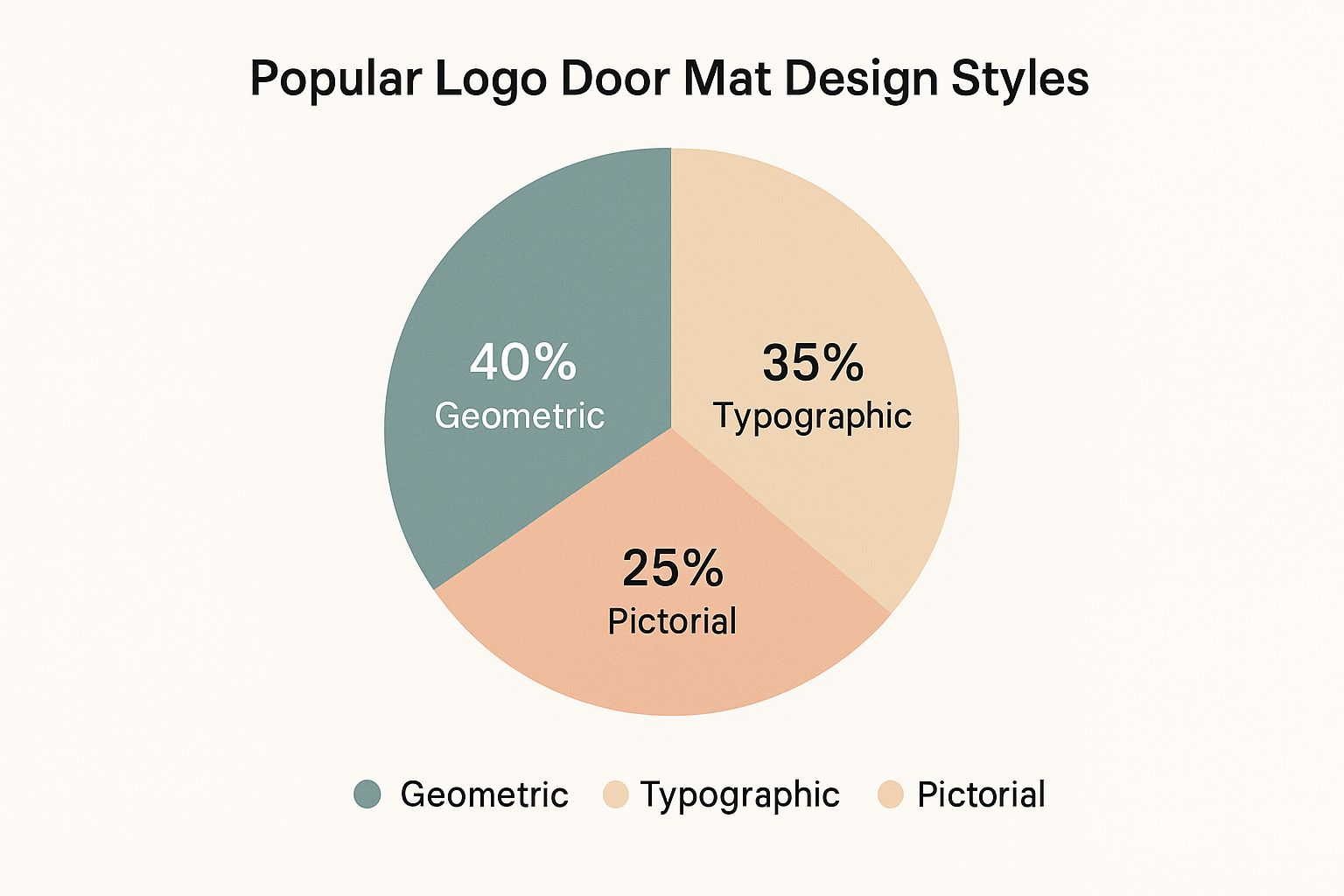
As the data shows, while classic pictorial logos are still common, a clear majority of businesses are choosing designs that focus on clean geometric patterns or bold typography to get their brand message across.
Comparing Common Logo Door Mat Materials
To make your decision even easier, we've put together this quick-glance table. Use it to compare the most common materials for logo door mats and find the perfect match for your needs based on durability, print quality, and ideal environment.
| Material Type | Best For | Durability | Logo/Print Quality | Maintenance |
|---|---|---|---|---|
| Nylon | Indoor entrances with high traffic; complex, colorful logos. | High | Excellent | Regular vacuuming; deep clean with an extractor. |
| Polypropylene | Indoor/covered outdoor areas; good moisture absorption. | Medium-High | Good | Vacuuming and occasional hose-down. |
| Coir | Outdoor entrances; aggressive dirt and mud scraping. | Medium | Fair (Best for simple, bold logos) | Shake out debris; avoid constant saturation. |
| Rubber | Outdoor/industrial areas; extreme weather and traffic. | Very High | Excellent (Molded logos are permanent) | Hose down to clean. |
This breakdown should give you a clear path forward. By weighing the environment against your branding goals, you can select a mat that not only looks fantastic on day one but continues to perform brilliantly for a long time to come.
How to Design Your Custom Logo Mat
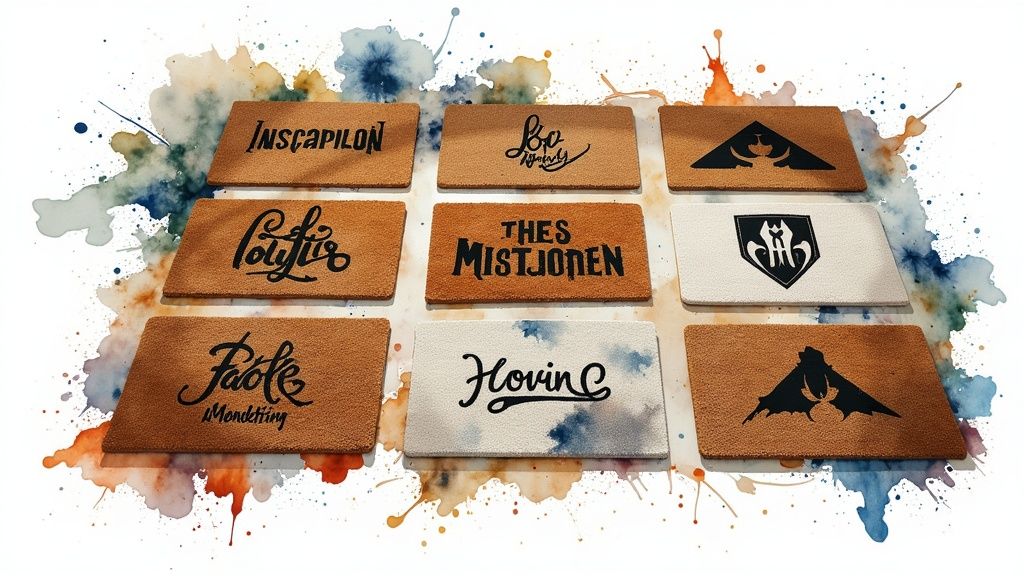
Turning your brand's logo into an eye-catching and effective door mat isn't about becoming a graphic design wizard overnight. It’s a straightforward process of making smart choices to ensure the final product truly represents your business.
Let's walk through the entire process, step-by-step. To make it real, we'll follow a fictional small business, 'The Daily Grind Cafe,' as they design their very first custom logo mat and see the practical decisions they face at each stage.
Step 1: Prepare Your Logo File
The quality of your final mat begins and ends with the quality of your digital logo file. To get that crisp, professional result you’re after, you need to provide your mat supplier with a vector file. You'll recognize these by their file extensions, which are usually .AI (Adobe Illustrator), .EPS, or a vector-based .PDF.
Unlike standard image files like a .JPG or .PNG, which are built from pixels, vector files are created with mathematical equations. This means a vector logo can be scaled to any size—from a tiny business card to a massive door mat—without ever losing quality or looking blurry.
- Real-World Example: The Daily Grind Cafe has a cool, detailed logo with a coffee cup icon and intricate text. If they sent over a low-resolution .JPG, the edges would look fuzzy and pixelated when blown up to mat size. By providing their original .AI file, they guarantee every line and curve stays perfectly sharp, delivering a polished, professional-looking final product.
Step 2: Choose the Right Size and Orientation
Next, decide on the mat's physical dimensions. This decision should be guided by function and visual balance, not guesswork. A mat that’s too small for an entryway looks awkward and won’t do a good job of capturing dirt.
Follow these simple steps to nail the perfect size:
- Measure Your Doorway: Grab a tape measure and get the full width of your door frame. A standard commercial door is typically 36 inches (about 91 cm) wide.
- Select a Width: For a single door, your mat should be at least as wide as the door itself, or even a little wider. This creates a balanced, welcoming look and maximizes its function. A common and effective choice is a 3’ x 5’ mat (approximately 91 cm x 152 cm).
- Choose an Orientation: Now, decide if your logo looks better in a "portrait" (taller than it is wide) or "landscape" (wider than it is tall) orientation. This will depend entirely on the shape of your logo and the space you have.
For double doors, the rule of thumb is to choose a mat that covers the width of both doors. This ensures a grand, proportional appearance that matches the entrance. A 6’ x 4’ mat (approximately 183 cm x 122 cm) often works perfectly here.
- Real-World Example: The Daily Grind Cafe has a standard 36-inch front door. They opt for a 3’ x 5’ mat in a landscape orientation. This size covers the entire entrance, looks balanced, and their wide, text-based logo fits beautifully within the space.
Step 3: Select the Production Method
Finally, you need to know how your logo will actually be put onto the mat. The two main methods are high-definition digital printing and the durable inlay technique. Your choice here will hinge on your logo's complexity and how much durability you need.
Digital Printing: This method works much like a high-tech inkjet printer, using specialized dyes that penetrate deep into the mat fibres. It’s the perfect choice for logos with lots of colours, subtle gradients, or very fine details.
Inlay Method: This is a more hands-on, artisan process. Your logo is precisely cut from different coloured pieces of material and then pieced together like a jigsaw puzzle. This creates an incredibly durable design that will never fade, because the colour runs through the entire thickness of the fibre. It’s best suited for logos with solid, distinct blocks of colour.
For a deeper dive into how different businesses leverage these options, you might find our guide on custom floor mats for business helpful.
- Real-World Example: The Daily Grind Cafe’s logo has a subtle colour gradient in its coffee cup icon. Because of this specific detail, digital printing is the ideal method to capture it perfectly. If their logo were just simple, bold text, the inlay method would have been a superior choice for maximum longevity.
The Hidden Benefits of a Quality Entrance Mat
While a vibrant logo is a fantastic branding asset, the real magic of a quality entrance mat lies in its hidden, functional benefits. These practical advantages deliver a serious return on your investment, turning a simple decorative piece into a hardworking operational tool that saves you money, time, and potential headaches.
Considering a logo mat as just a branding piece is like only seeing the tip of an iceberg. The real value is what's happening just below the surface:
The First Line of Defense Against Dirt
Every person who walks through your door brings a little piece of the outside world with them on their shoes. A high-performance logo door mat is engineered to aggressively scrape and trap that dirt, dust, and moisture before it ever gets a chance to spread through your building.
A quality entrance mat can trap up to 85% of the dirt and moisture brought into a building. This simple tool is one of the most effective ways to keep your interior clean.
This trapping action has an immediate and direct impact on your bottom line. When you stop dirt at the door, you can drastically cut down on the time and money spent on sweeping, mopping, and vacuuming.
- Real-World Example: Picture a busy shop on a rainy day. Without a good entrance mat, the doorway quickly becomes a messy, hazardous mix of water and mud. Employees are pulled away from customers to constantly mop the floor. With a high-quality, absorbent logo mat, however, most of that moisture is contained right at the entrance, keeping floors safer and freeing up your team to focus on sales.
Protecting Your Flooring Investment
That grit and grime carried in on shoes acts just like sandpaper on your interior floors. Over time, this constant abrasion wears down the finish on hardwood, scratches expensive tile, and grinds down the fibers of your carpets. This leads to premature aging and, eventually, costly repairs or a full replacement.
A quality entrance mat acts as a crucial buffer zone, protecting this significant investment. By capturing the vast majority of abrasive particles right at the door, you extend the life of your interior flooring and keep it looking its best for years to come.
A Critical Tool for Safety and Liability
Perhaps the most critical "hidden" benefit of a proper entrance mat is its role in improving safety. Slips, trips, and falls are a leading cause of injuries in commercial spaces, creating a huge liability risk for any business. And wet, slippery entryways are one of the most common culprits.
A well-designed logo door mat provides a secure, non-slip surface for everyone to walk on, especially during wet weather. Its absorbent qualities help contain moisture, preventing dangerous puddles from forming on hard floors like tile or polished concrete.
The growing focus on safety and cleanliness is reflected in the market itself. The entrance matting industry was valued at roughly USD 6.61 billion in 2023 and is projected to grow steadily. This growth is fueled by businesses recognizing that effective matting isn't an expense—it's a smart investment to lower cleaning costs and minimize slip hazards. You can see more data on this trend by reviewing the full research on the entrance matting market.
Actionable Takeaways for Your Business:
- Reduce Cleaning Labour: By trapping dirt at the door, you immediately lower the time your staff spends on floor maintenance.
- Protect Flooring Assets: Extend the lifespan of your interior carpet, tile, or hardwood by stopping abrasive grit from being tracked inside.
- Minimise Slip-and-Fall Risks: Enhance visitor and employee safety by keeping entryways dry and secure, which in turn reduces your liability exposure.
Changing how you see your entrance mat is key. It's not just a welcome sign; it's an essential piece of equipment working tirelessly to keep your facility clean, safe, and cost-efficient. To dig a bit deeper into how one item can make such a big difference, we've explored the importance of a logo mat in more detail in another article.
How to Keep Your Mat Looking Brand New
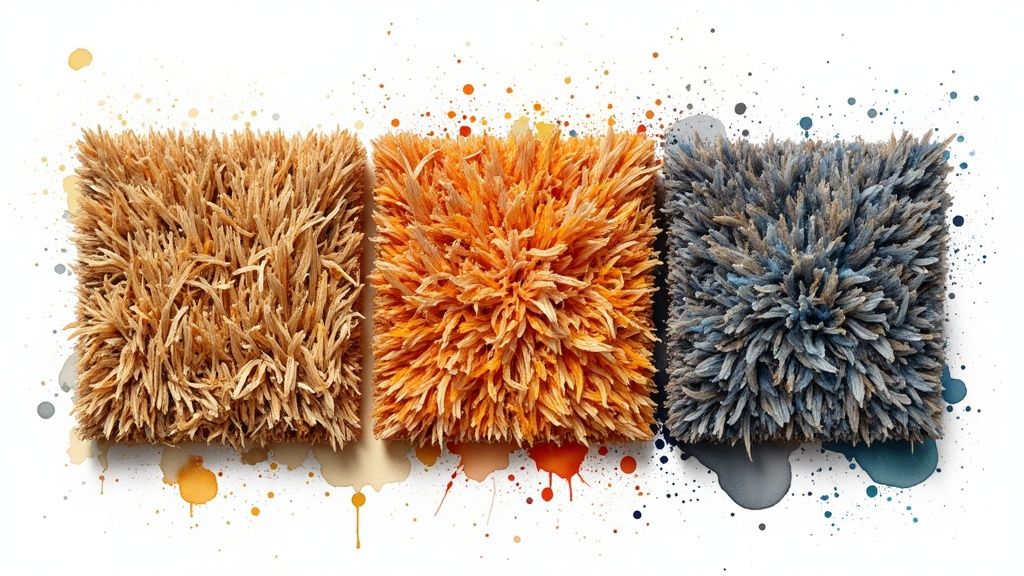
A clean, vibrant logo mat sends a powerful message. It tells visitors you’re professional and you care about the details. But a dirty, faded mat? It can subtly undermine your brand’s image. Protecting your investment requires consistent care, but it’s a simple process that keeps your entrance looking professional for years.
Think of your logo mat as the uniform for your entrance—it needs to stay sharp. The right approach depends on the mat’s material and how much foot traffic it sees.
Create a Simple Cleaning Schedule
The first step is to set a realistic cleaning schedule based on how busy your entrance is. Remember, consistency is far more important than intensity. There’s no one-size-fits-all answer, so adjust your routine to match your specific needs.
- High-Traffic Areas (e.g., Hotel Lobbies, Major Retail Stores): These mats need daily attention. A quick vacuum and spot-cleaning any obvious spills will keep them looking great.
- Medium-Traffic Areas (e.g., Corporate Offices, Clinics): A thorough cleaning 2-3 times per week is usually more than enough to keep things looking sharp.
- Low-Traffic Areas (e.g., Small Boutiques, Private Offices): A solid weekly cleaning is often all it takes to keep the mat looking fresh.
Pro Tip: Your cleaning schedule isn't set in stone. When it's rainy or snowy, even low-traffic spots might need a daily wipe-down to handle the extra water and salt. Be ready to adapt your routine when the weather turns.
Cleaning Instructions for Different Materials
Different mat materials need different cleaning methods. Using the wrong technique can do more harm than good. Here’s a quick "how-to" guide for the most common types of logo door mats.
For Coir (Coconut Fibre) Mats:
These natural fibre mats are amazing for scraping off mud, but they don't like getting soaked.
- Shake It Out: The best first move is to take the mat outside and give it a really hard shake to knock out all the trapped dirt.
- Scrape It Clean: Use a stiff-bristled brush to get rid of any stubborn, caked-on mud.
- Vacuum It Up: Finish with a good vacuuming to pull out the finer dust particles hiding in the fibres.
For Rubber Mats:
These are the champs of durability and by far the easiest to clean.
- Hose It Down: Just take it outside and give it a good spray with a hose.
- Scrub if Needed: For tougher grime, a bit of mild detergent and a brush will make it look new again.
- Rinse and Dry: Rinse it well and hang it up or lay it flat to air dry completely before putting it back.
For Nylon or Polypropylene (Carpet-Top) Mats:
These mats need care that’s similar to indoor carpeting to keep that printed logo looking crisp.
- Daily Care: Regular vacuuming is your best friend here. It stops surface dirt from getting ground deep into the fibres.
- Spot Treatment: Tackle spills right away. Blot them—don't rub!—with a clean cloth and a gentle cleaner.
- Deep Cleaning: For a serious refresh, a carpet extractor with a mild, low-foaming detergent works wonders. It washes the fibres and pulls out all the dirty water, restoring the mat’s colour and pop.
For a more detailed breakdown, check out these 5 tips on how to keep your entrance mat clean to make sure your maintenance routine is on point.
Strategic Placement for Maximum Brand Impact
Why let your branding stop at the front door? While the main entrance is crucial, strategically placing logo door mats throughout your building can seriously amplify your brand's presence and create a polished, cohesive experience. If you're limiting this powerful tool to just one spot, you're missing a huge opportunity to reinforce your identity at multiple key touchpoints.
When you think beyond the main entrance, your logo mats transform from a simple welcome into a smart part of your facility's branding and operational strategy.
Expanding Your Brand's Footprint
Take a moment and consider all the high-traffic or important areas inside your building. Each one of these spots is a chance to make a solid impression on clients, visitors, and even your own team.
- At the Reception Desk: Placing a logo mat right in front of the reception desk does more than just protect the floor. It creates a designated, branded spot for visitors to stand, making the whole area feel more official and well-planned.
- Inside Elevators: An elevator is, for a brief moment, a captive space. A custom logo mat inside gives you a moment of focused brand exposure and adds a real touch of class to an otherwise plain box.
- Key Transition Points: Use logo door mats at the junctions between different departments. A great example is placing a mat at the doorway between a dusty manufacturing floor and the clean administrative offices. It clearly defines the space while doing the heavy lifting of trapping debris.
Your goal here is to create a seamless brand journey. Every strategically placed mat adds another piece to the puzzle, building a unified environment that subtly communicates that quality and professionalism are at the core of your business.
Real-World Placement Strategies
Let's look at how this plays out for different types of businesses.
Example 1: The Fitness Center
A gym doesn't just put a branded mat at the main entrance. They also place them at the doorways to the locker rooms and the weight room. This keeps the brand consistent throughout a member's entire visit and helps manage moisture and dirt in those specific zones, enhancing safety and cleanliness.
Example 2: The Corporate Campus
Imagine a large company with several buildings on one campus. By using matching logo door mats in each building's foyer, they tie the entire campus together. It's a simple move that creates a consistent brand experience for employees and visitors, no matter which building they happen to enter.
This broader approach to branding is catching on. The global door mat market is seeing some serious growth, with projections suggesting it could hit over USD 13.88 billion by 2034. This boom is being driven by businesses looking for customized solutions that boost both looks and function. You can dive deeper into these market dynamics at Global Growth Insights.
By seeing your entire facility as a canvas, you can use logo mats to craft a much stronger, more memorable brand presence. If you're looking for more ways to bolster your brand's image, be sure to check out our guide on how to enhance brand recognition using corporate logo mats.
Frequently Asked Questions About Logo Mats
When you're ready to invest in a custom mat, it's normal to have a few questions. Getting clear answers is the best way to make a confident choice that fits your brand and your budget perfectly.
We've put together answers to some of the most common questions we get about logo door mats, giving you straightforward, practical info to guide you.
How Long Will the Logo on My Door Mat Last?
The lifespan of your logo really comes down to two things: the mat's material and how the design was applied.
For a logo that needs to survive heavy foot traffic, inlaid mats are the undisputed champions. With an inlaid mat, the logo isn't just printed on top. Instead, it's built right into the mat using different colored pieces of fiber. Since the color goes all the way through the material, the design can't wear off—it will last as long as the mat itself.
High-quality digitally printed mats are also incredibly tough. The process uses special dyes that sink deep into the mat's fibers, making them highly resistant to fading. With proper care, these logos can look sharp for years. Cheaper, surface-printed mats, on the other hand, will likely start showing their age much sooner.
Key Takeaway: For busy entrances where durability is everything, an inlaid mat is the smartest long-term investment. For complex, colorful designs, a high-quality digitally printed mat gives you that perfect mix of crisp visuals and lasting performance.
Can I Order Just One Custom Mat?
Yes, you absolutely can. Many modern suppliers, ourselves included, know that not every business needs to order in bulk. We have a minimum order quantity (MOQ) of just one mat.
This flexibility opens the door for everyone to get professional branding. Whether you're a small startup, a single retail shop, or a business that just wants to test a new design before committing to a larger order, you can get exactly what you need.
Of course, if you're a company needing multiple logo door mats for different entrances or locations, suppliers almost always offer volume discounts. Ordering more at once usually makes each mat more affordable. It's always a good idea to check the MOQ and pricing tiers with your provider.
Will a Complex Multi-Colored Logo Work on a Mat?
It sure will. Today’s mat production technology can handle incredibly complex and colorful logos with stunning accuracy. This is where digital printing really comes into its own.
- Real-World Example: Think of a real estate agency with a logo that has a subtle color gradient in its house graphic. That's no problem. The digital printing process can capture those fine details and smooth color shifts perfectly.
The one crucial thing you need to do is provide a high-resolution vector file—something like an .AI, .EPS, or a vector .PDF. This type of file is essential because it allows your design to be scaled up to any mat size without getting blurry or pixelated. The result is a crisp, professional mat that’s a perfect reflection of your brand.
Ready to create a lasting first impression? Mats4U offers a wide range of high-quality, fully customizable logo door mats designed to meet the needs of any business. From durable rubber to vibrant nylon, we have the perfect solution to enhance your brand and protect your facility.

